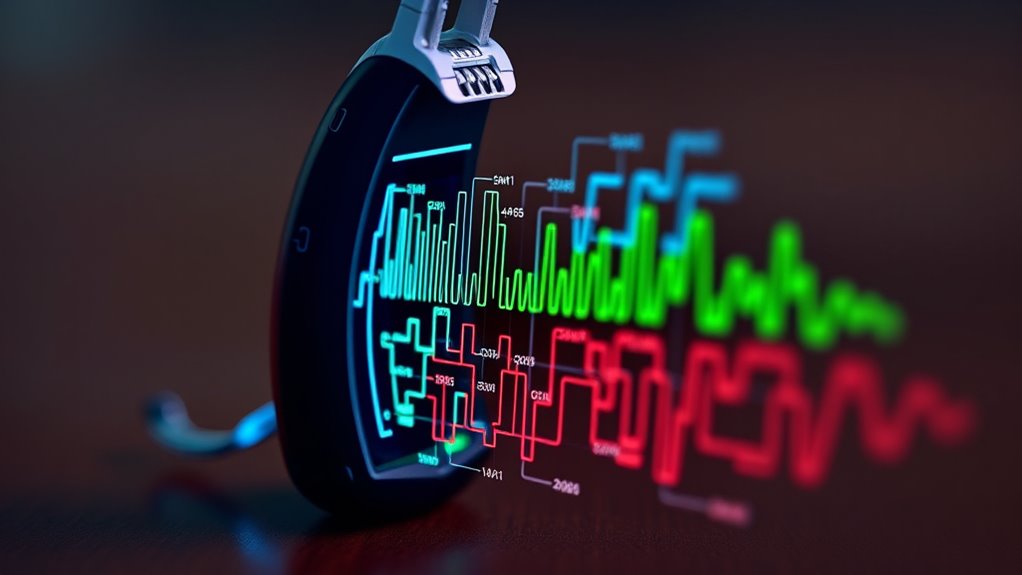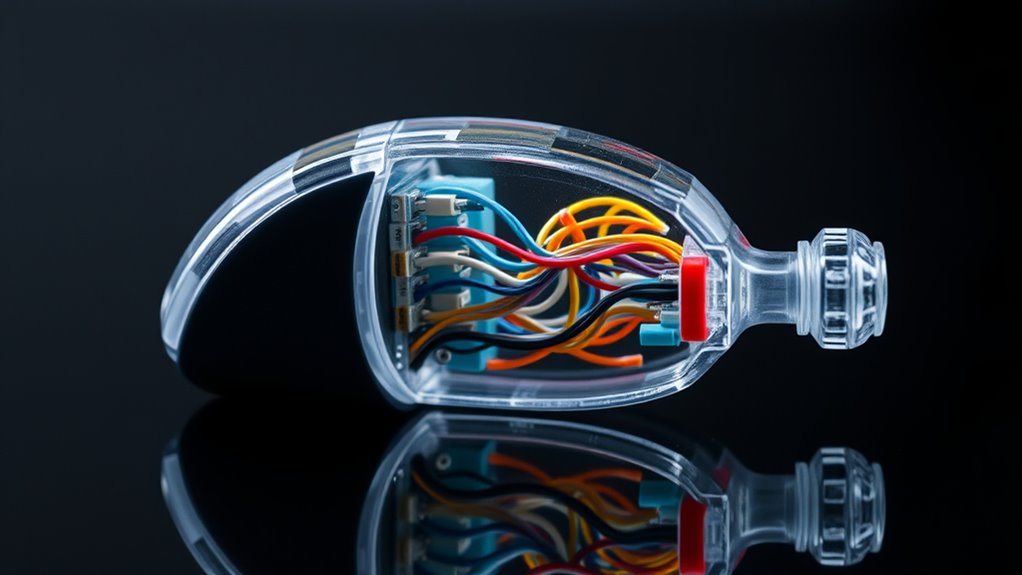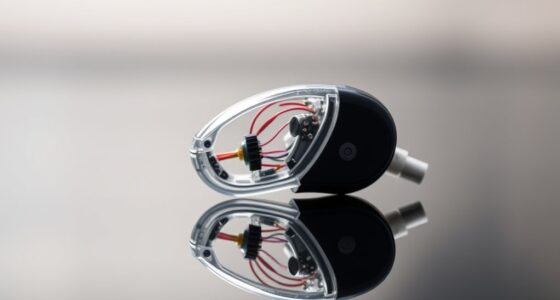Hearing aid channels and bands are key to customizing how your device processes sound. Channels split the frequency spectrum into parts, allowing precise control over different sounds, while bands focus on specific frequency ranges to improve speech clarity and reduce background noise. By adjusting these settings, you can personalize your hearing experience for different environments. If you want to understand how these features work together to optimize your hearing, further details are just a moment away.
Key Takeaways
- Hearing aid channels process specific frequency ranges independently for targeted sound amplification and noise reduction.
- Frequency bands divide the audio spectrum to enhance speech clarity and reduce background noise.
- Increasing channels and bands allows for more precise sound customization but may impact battery life.
- Personalization involves adjusting channels and bands to optimize sound quality for different environments.
- Modern devices use wireless connectivity and automatic adjustments to improve listening comfort and efficiency.
What Are Hearing Aid Channels?

Hearing aid channels are specific frequency ranges that the device can process and amplify separately. This setup allows your hearing aid to target different sounds more accurately, improving clarity and comfort. With multiple channels, noise reduction features become more effective, as the device can distinguish speech from background noise better. Additionally, some advanced hearing aids incorporate music enhancement settings to optimize sound quality for music listening. However, increasing the number of channels can also impact battery life, since the device works harder to process more frequencies. Balancing the number of channels and power consumption is essential for ideal performance. Fewer channels may conserve battery life but might not fine-tune sound as precisely. Understanding how channels work helps you choose a hearing aid that offers the right mix of noise reduction and battery efficiency for your needs.
The Role of Frequency Bands in Sound Processing

While channels break sound into manageable sections, frequency bands further refine how your hearing aid processes different sounds. They segment the auditory spectrum based on sound frequency, allowing the device to target specific ranges of sound. This precise division enables your hearing aid to amplify important sounds, like speech, while reducing background noise. The role of frequency bands is vital in customizing your hearing experience, ensuring clarity and comfort across various environments. By focusing on particular sound frequency ranges, your hearing aid can enhance speech intelligibility and improve overall sound quality. A well-designed system of frequency bands helps your device adapt dynamically to different sounds, making conversations clearer and everyday sounds more natural. This fine-tuning is essential for peak hearing performance. Frequency band configuration plays a crucial role in optimizing sound processing for individual needs.
How Channels Help Personalize Hearing Experience

Channels allow your hearing aid to make precise sound adjustments, so you hear more clearly in different environments. They enable the device to create customized listening profiles tailored specifically to your hearing needs. This personalization guarantees a more natural and comfortable hearing experience every day. High-quality sound reproduction relies on effective channel management to optimize clarity across various listening situations.
Precise Sound Adjustment
By dividing sounds into multiple channels, hearing aids can finely tune different frequencies to match your unique hearing profile. This precise sound adjustment allows you to better distinguish speech from background noise, enhancing speech clarity in busy environments. With tailored amplification, you can focus on conversations without being overwhelmed by unwanted sounds. Regular assessment and adjustment ensure your hearing aid continues to meet your evolving needs.
Customized Listening Profiles
Customizing your hearing experience becomes easier when your hearing aid uses multiple channels to tailor sound settings precisely to your needs. These channels allow the device to focus on specific sounds, enhancing speech clarity while reducing background noise through noise suppression. With personalized listening profiles, your hearing aid can automatically adjust settings based on your environment, providing seamless progressions between quiet conversations and noisy places. Feedback management is also improved, preventing whistling or squealing that can disrupt your hearing. Multiple channels enable your device to fine-tune sound quality in real-time, ensuring comfort and clarity. Overall, customized profiles help you enjoy a more natural listening experience, making your hearing aid adapt effortlessly to your daily activities. Enhanced sound customization allows your device to respond dynamically to changing environments, further improving your listening experience.
The Difference Between Channels and Bands

Channels split your hearing aid’s processing into separate segments, each tailored to specific sounds, while bands cover broader frequency ranges to shape the overall sound. Understanding how each function helps you see how your device manages different pitches and noise. This distinction is key to customizing your hearing experience effectively, especially when considering frequency management in modern hearing aid tuning.
Channel Functionality Overview
Understanding the difference between channels and bands is key to grasping how hearing aids process sounds. Channels divide incoming audio into separate streams, allowing precise amplification, while bands group frequencies within each channel for targeted adjustments. This setup ensures clear sound clarity and effective noise reduction. Modern hearing aids utilize wireless connectivity to streamline adjustments and improve user experience, while efficient channel management helps conserve battery life. Smart technology in hearing aids enhances their ability to adapt automatically to different listening environments, providing users with a more seamless experience.
Band Frequency Range
Have you ever wondered how hearing aids differentiate sounds across various frequencies? It all comes down to the band frequency range. Unlike channels, which split the audio spectrum into smaller segments, bands focus on specific frequency ranges within that spectrum. A sound wave’s frequency determines whether it’s a bass note or a high-pitched whistle. Hearing aids adjust amplification based on these ranges to enhance speech clarity and reduce background noise. The band frequency range defines the limits within which the device processes sounds, targeting particular parts of the audio spectrum. This precise control helps you hear more naturally, emphasizing important sounds while filtering out unwanted noise. Understanding this distinction allows you to better appreciate how hearing aids tailor sound to your unique hearing needs. Additionally, audio processing plays a crucial role in how effectively a hearing aid manages different sound environments.
Adjusting Channels and Bands for Optimal Hearing

To achieve the best hearing experience with your aid, you need to carefully adjust the channels and bands. Proper tuning ensures clarity, reduces background noise, and preserves battery life. When optimizing, consider how noise reduction features can be enhanced by fine-tuning specific channels, helping you focus on speech. Balancing channels also prevents sound fatigue and extends battery life by avoiding unnecessary processing. Here are key points to keep in mind:
- Customize channels to match your environment, minimizing noise interference
- Adjust bands to improve speech clarity and reduce background noise
- Regularly review and fine-tune settings to optimize battery efficiency and overall performance
- Remember that special occasions such as celebrations or gatherings may require different settings to maintain optimal hearing in various environments.
Effective adjustments help you enjoy clearer sound, longer battery life, and better noise management in various situations.
Technological Advances in Channel and Band Management

Recent technological advances have markedly improved how hearing aids manage channels and bands, allowing for more precise and adaptable sound processing. Modern devices now feature wireless connectivity, enabling seamless streaming from smartphones and other devices, which enhances user experience and reduces the need for manual adjustments. Additionally, these innovations have prioritized battery efficiency, extending usage time without sacrificing performance. Advanced algorithms automatically optimize channel and band settings based on your environment, ensuring clearer sound quality in noisy settings or quiet spaces. This automation reduces the need for constant manual tuning, making hearing aids more user-friendly. Moreover, the integration of cookies and data tracking in some devices helps tailor sound profiles to individual preferences and environments. Overall, these technological developments make hearing aids smarter, more connected, and longer-lasting, substantially improving your hearing experience while simplifying device management.
Frequently Asked Questions
Can Channels and Bands Be Customized Over Time?
Yes, you can customize channels and bands over time. With channel customization, your audiologist can adjust the number of channels to better suit your hearing needs. Band adjustment allows fine-tuning of specific frequencies for clearer sound. As your hearing evolves, these adjustments help optimize your hearing aid’s performance, ensuring you get the most out of your device. Regular check-ins make it easy to keep your hearing experience comfortable and effective.
How Do Channels Affect Battery Life in Hearing Aids?
Imagine your hearing aid as a busy chef juggling ingredients. More channels mean more signal processing, which increases battery consumption because the device works harder. This extra effort drains power faster, much like a chef using more energy to prepare complex dishes. So, you’ll notice that adding or increasing channels can shorten battery life, making it essential to find a balance between sound quality and device longevity.
Are More Channels Always Better for Hearing Clarity?
More channels aren’t always better for hearing clarity. While increased channel differentiation and finer frequency segmentation can help you hear specific sounds more clearly, too many channels might cause processing delays or sound quality issues. It’s about finding the right balance for your needs. Your hearing healthcare professional can adjust the number of channels to optimize clarity without overcomplicating the sound, ensuring you get the best hearing experience.
Do Different Hearing Aid Brands Use the Same Channel/Band System?
Ever wonder if hearing aid brands speak the same language? While many follow a common channel standardization, brand variations still exist. Some brands use unique channel and band systems to tailor sound processing, which can influence your experience. Don’t assume all devices are identical; understanding these subtle differences helps you choose the best hearing aid for your needs. Always ask your audiologist about specific brand features and how they impact clarity.
How Do Channels Impact Hearing Aid Compatibility With Other Devices?
Channels influence how well your hearing aid works with other devices by shaping its digital signal processing and frequency management. When your hearing aid has more channels, it can better distinguish sounds and reduce interference, improving compatibility with Bluetooth or remote controls. If the channels aren’t well-matched, you might experience audio lag or poor sound quality. So, choosing a device with appropriate channels guarantees smoother interaction and clearer, more natural sound.
Conclusion
Understanding channels and bands is like revealing a secret code to better hearing. By customizing these elements, you turn your hearing aid into a finely-tuned instrument that adapts perfectly to your world. Think of it as your personal symphony—each channel and band playing its part. With advances in technology, your hearing experience becomes more natural and vivid. Isn’t it time you let your hearing aid compose the perfect harmony just for you?











